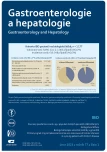Two years of the COVID-19 pandemic in the population of Czech patients with infl ammatory bowel disease treated with bio logical therapy – experience of the tertiary IBD center
Authors:
Karin Černá
; M. Lukáš
Authors‘ workplace:
Klinické a výzkumné centrum pro střevní záněty, Klinické centrum ISCARE a. s. a 1. LF UK v Praze
Published in:
Gastroent Hepatol 2023; 77(1): 14-20
Category:
doi:
https://doi.org/10.48095/ccgh202314
Overview
Background: Inflammatory bowel disease (IBD) may be associated with a more severe course of infections and a different response to vaccination, especially in complicated IBD course and in association with immune-modifying IBD treatment. The aim of this study was to describe COVID-19 pandemic during years 2020–2022 in IBD patients with long-term biological therapy. Methods: A retrospective analysis of SARS-CoV-2 infection incidence in the population of 1,177 IBD (Crohn’s disease or ulcerative colitis) patients with long-term biological therapy (IBD cohort) was performed. The incidence rate, crude incidence rate and standardized incidence ratio of COVID-19 in the IBD cohort, the odds ratio of infection depending on the type of biologic therapy administered, the dynamics of COVID-19 incidence depending on the predominant SARS-CoV-2 variant in the population and the current vaccination coverage of the IBD cohort were calculated. Results: From January 2020 to April 2022, 548 confirmed cases of COVID-19 (46.6%) were reported in the IBD cohort, with 39% share of PCR positivity in vaccinated individuals and with 95% occurrence of infection in unvaccinated part of the IBD cohort. Standardized incidence rate ratio of COVID-19 was 27% higher in the IBD cohort compared to the general Czech population. The dynamics of the development of the number of positive cases of COVID-19 in the IBD cohort was identical to the situation in the entire country. A higher odds ratio of the chances of infection was demonstrated in patients treated with tumor necrosis factor inhibitors, but not in patients treated with anti-integrins or monoclonal antibodies against interleukins. In the IBD cohort, 85.2% of patients were properly vaccinated, which was significantly more than the vaccination rate of the entire Czech population. Discussion and conclusion: During the two pandemic years, the incidence of COVID-19 in patients with severe IBD and long-term biological treatment was higher compared to the general Czech population, despite the favorable vaccination coverage of this high-risk patients’ group. A higher risk was associated with tumor necrosis factor inhibitor therapy.
Keywords:
inflammatory bowel disease – Crohn’s disease – ulcerative colitis – COVID-19 – SARS-CoV-2 – vaccination – biological therapy
Sources
1. Lin S, Lau LH, Chanchlani N et al. Recent advances in clinical practice: management of inflammatory bowel disease during the COVID-19 pandemic. Gut 2022; 71 (7): 1426–1439. doi: 10.1136/gutjnl-2021-326784.
2. Cerna K, Duricova D, Hindos M et al. Cellular and humoral immune responses to SARS-CoV-2 vaccination in inflammatory bowel disease patients. J Crohns Colitis 2022; 16 (9): 1347–1353. doi: 10.1093/ecco-jcc/jjac048.
3. Cerna K, Duricova D, Lukas M et al. Anti-SARS-CoV-2 Vaccination and Antibody Response in Patients With Inflammatory Bowel Disease on Immune-modifying Therapy: Prospective Single-Tertiary Study. Inflamm Bowel Dis 2022; 28 (10): 1506–1512. doi: 10.1093/ibd/izab 301.
4. Covid portál. 2022 [online]. Dostupné z: https: //koronavirus.mzcr.cz/.
5. Riffe T, Accosta E, the COVerAGE-DB team. Data Resource Profile: COVerAGE-DB: a global demographic database of COVID-19 cases and deaths. Int. J Epidemiol 2021; 50 (2): 390–390f. doi: 10.1093/ije/dyab027.
6. United Nations, Department of Economic and Social Affairs, Population Division. World Population Prospects 2019: Highlights. ST/ESA/SER.A/423. 2019 [online]. Dostupné z: https: //population.un.org/wpp/publications/files/wpp2019_highlights.pdf.
7. World Health Organization. 2022 [online]. WHO/2019-nCoV/Surveillance_Case_Definition/2020.1. Dostupné z: https: //www.who.int/publications/i/item/WHO-2019-nCoV-Surveillance_Case_Definition-2022.
8. Komenda M, Jarkovský J, Klimeš D et al. Sharing datasets of the COVID-19 epidemic in the Czech Republic. PLoS One 2022; 17 (4): e0267397. doi: 10.1371/journal.pone.0267397.
9. World Health Organization. 2022 [online]. Dostupné z: https: //covid19.who.int/re- gion/euro/country/cz.
10. United Nations World population prospects 2019. 2022 [online]. Dostupné z: https: //population.un.org/wpp/Download/Standard/ Population/.
11. Amiot A, Rahier JF, Baert F et al. I-CARE collaborator group. The impact of COVID-19 on patients with IBD in a prospective European cohort study. J Crohns Colitis 2022; jjac091. doi: 10.1093/ecco-jcc/jjac091.
12. Zhou F, Yu T, Du R et al. Clinical course and risk factors for mortality of adult inpatients with COVID-19 in Wuhan, China: a retrospective cohort study. Lancet 2020; 28: 395 (10229): 1054–1062. doi: 10.1016/S0140-6736 (20) 30566-3.
13. Volz E, Mishra S, Chand M et al. Assessing transmissibility of SARS-CoV-2 lineage B.1.1.7 in England. Nature 2021; 593 (7858): 266–269. doi: 10.1038/s41586-021-03470-x.
14. Xia S, Wen Z, Wang L et al. Structure-based evidence for the enhanced transmissibility of the dominant SARS-CoV-2 B.1.1.7 variant (Alpha). Cell Discov 2021; 7 (1): 109. doi: 10.1038/s41421-021-00349-z.
15. Liu C, Ginn HM, Dejnirattisai W et al. Reduced neutralization of SARS-CoV-2 B.1.617 by vaccine and convalescent serum. Cell 2021; 184 (16): 42204236.e13. doi: 10.1016/j.cell.2021.06.020.
16. Yang H, Liu P, Zhang Y et al. Characteristic analysis of Omicron-included SARS-CoV-2 variants of concern. MedComm 2022; 3 (2): e129. doi: 10.1002/mco2.129.
17. Arora P, Kempf A, Nehlmeier I et al. Augmented neutralisation resistance of emerging omicron subvariants BA.2.12.1, BA.4, and BA.5. Lancet Infect Dis 2022; 22 (8): 1117–1118. doi: 10.1016/S1473-3099 (22) 00422-4.
Labels
Paediatric gastroenterology Gastroenterology and hepatology SurgeryArticle was published in
Gastroenterology and Hepatology

2023 Issue 1
- Metamizole vs. Tramadol in Postoperative Analgesia
- Metamizole at a Glance and in Practice – Effective Non-Opioid Analgesic for All Ages
- Current Insights into the Antispasmodic and Analgesic Effects of Metamizole on the Gastrointestinal Tract
- Obstacle Called Vasospasm: Which Solution Is Most Effective in Microsurgery and How to Pharmacologically Assist It?
- Spasmolytic Effect of Metamizole
Most read in this issue
- Autoimmune hepatitis after vaccination against COVID-19
- Primary signet ring cell adenocarcinoma as a rare cause of colonic stenosis in a young patient with Crohn’s disease – the case report
- Gastrointestinal dysfunctions and their influence on the quality of life in aging adults with spinal cord injury
- Biological therapy of ulcerative colitis during pregnancy
